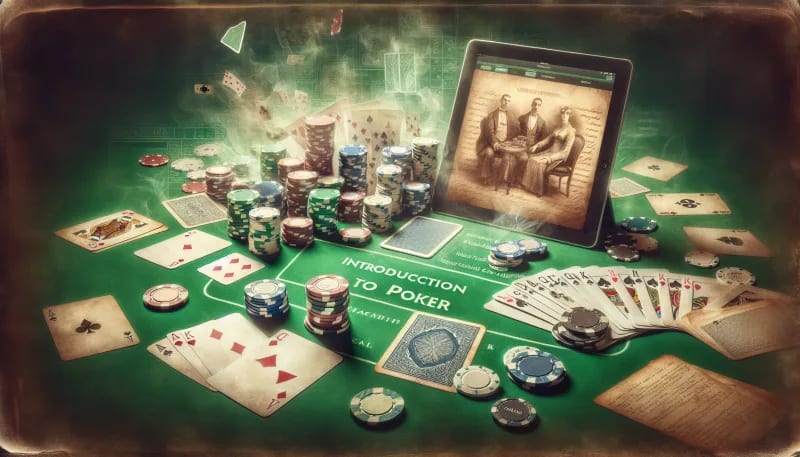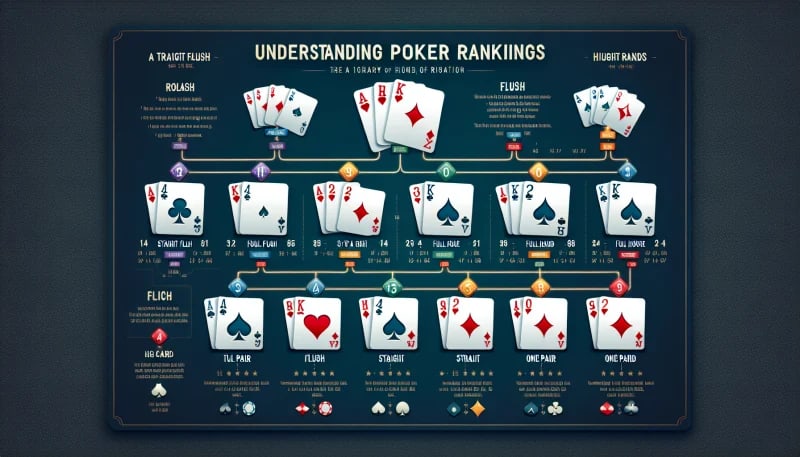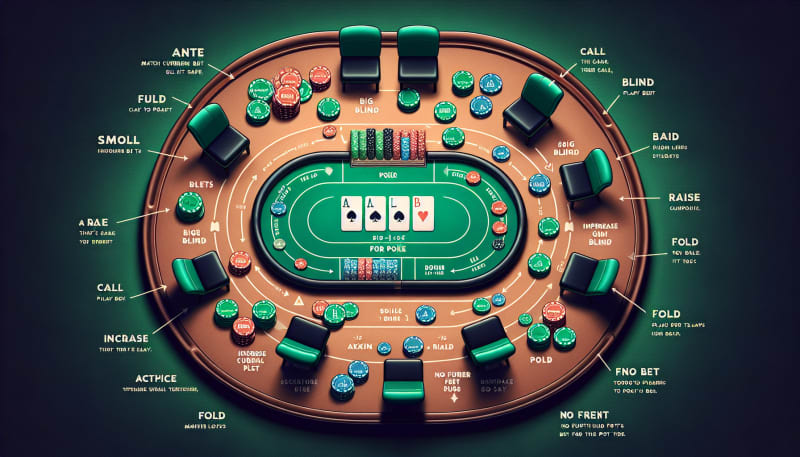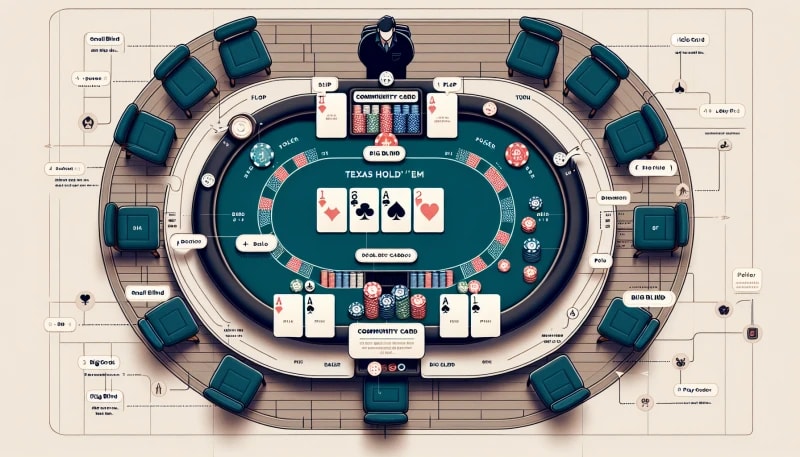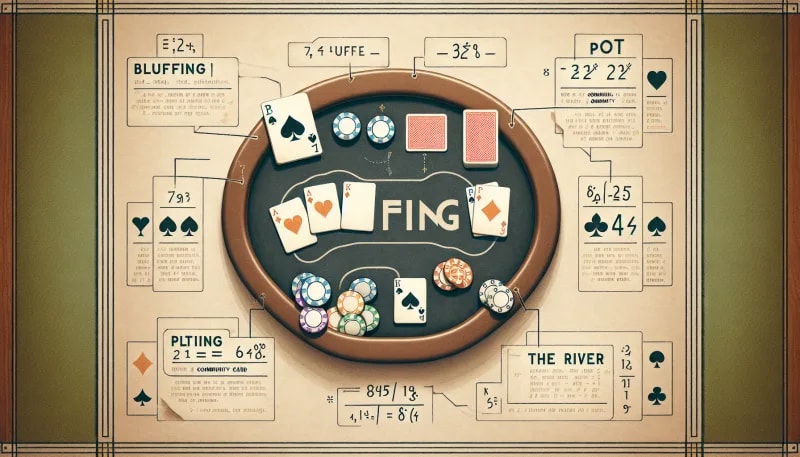Poker for Beginners: Mastering Hand Rankings and the Basics of Gameplay
Introduction to Poker
Poker isn't just a card game; it's a cultural phenomenon. Have you ever wondered how poker cemented itself as an iconic pastime across the globe? Its origins date back to the early 19th century, and over time, it's morphed into a myriad of variations, each with its own set of rules and appeal. From the saloons of the Wild West to today's glittering casinos and virtual tables online, poker has evolved into a game that's now synonymous with strategy, psychology, and yes, a little bit of luck.
The cultural significance of poker cuts deep. It's been glamorized in movies, sung about in tunes, and it's a staple in homes and casinos alike. Whether it's the high-stakes world of professional play or a casual game among friends, it transcends age, background, and geography. Think about it, when was the last time you saw a movie where a tense poker scene didn't keep you on the edge of your seat?
Now, let's talk about the heart of the game—its objective. At its core, poker is about assembling the best possible hand or skillfully convincing others you have done so. Why does this simple premise captivate millions? Because it's not just about the cards you're dealt, but how you play them. The thrill of the bluff, the strategy of the bet, and the read of your opponent make poker an endlessly engaging challenge.
As we gear up to delve into the nuts and bolts of the game, it's crucial to appreciate the layers that make poker the enthralling strategic pastime it is. But before diving into strategies and gameplay tactics, understanding the hierarchy of hands is a must. And that's precisely what we'll explore next in "Understanding Poker Hand Rankings".
Are you ready to unravel the secrets of a Royal Flush, the rarity of a Straight Flush, or the strength of a Full House? To truly appreciate the game's intricacies, a firm grasp of these rankings is paramount. Let's shuffle up and deal into the world of poker.
Understanding Poker Hand Rankings
In the previous section, we dipped our toes into the vast ocean of poker with an introduction to the game. Now, let's delve deeper and tackle poker hand rankings. They're your bread and butter on the felt. Remember, knowing these by heart is as vital as the air you breathe at the table.
Royal Flush, ever heard of the jewel in the poker crown? It's the ace-high straights of all the same suit - think A, K, Q, J, 10, all in hearts. The crème de la crème of poker hands, unwaveringly holding the fort at the top.
Then, we have the Straight Flush, five consecutive cards of the same suit. Imagine holding a 7 through to 3 of clubs. That's a sweet hand, but can you top a royal?
Four of a Kind slots in next. Picture four deuces staring back at you. It sends a thrill down your spine, doesn't it? Yet, in the rare showdown, those deuces could still lose to a straight flush above them.
Full house? We're not talking about a crowded party. It's the union of a Full House - a trio of one rank with a pair of another, say, 8-8-8 with 4-4. It's a strong hand, tough to beat, and a real game-changer.
A Flush - five cards of the same suit, not in sequence - follows. Could you turn down five diamonds glinting in your hand? Of course not, but always check for higher flushes out there.
Just below is the Straight. Think of a sequence like 5-4-3-2-A. This can be mixed suits, but non-sequential ranks would break the flow.
Three of a Kind? It says it all. Three cards, same rank, buddies for life, or at least the hand.
Two pairs of different ranks give you a Two Pair. Decent, but is it sturdy enough to withstand the storm of higher ranks?
A single pair, aptly named Pair, sits just above our base, and finally, the High Card. It's like arriving at a gunfight brandishing a spoon. Not ideal, but hey, sometimes that ace high can still clinch victory from the jaws of defeat.
So, are you ready to pit these ranks against each other in the battleground of betting? Each hand you're dealt is a new story, a new adventure. And remember, a well-known hand ranking chart can serve as your trusty sidekick. Check one out here.
In our next segment, "The Basics of Betting," we gear up to use this intel. I'll guide you through wielding the power of your hands to outsmart your opponents and stack those chips high. Ready to raise the stakes?
The Basics of Betting
Knowing your poker hand rankings is one thing, but mastering the betting rounds? That's where the real game lies. So, what are these rounds and why should you care? Picture this: each bet you place is a strategic move, like a chess piece inching closer to checkmate.
First up, let's look at the ante. It's the ante that gets the pot going, a small, mandatory bet each player contributes before the hand starts. It's like buying your way into the action. Not all poker variations use it, but when they do, think of it as the entry ticket to the game – small, but crucial.
Now, the blind. In games like Texas Hold'em and Omaha, there are no antes. Instead, we have the small and big blind, rotating bets that the players to the left of the dealer make to ensure there's always some chips in the pot. Ever heard the term "blindly going in"? That's not the strategy you want – even your forced bets should align with your game plan.
On to making those active decisions – to call, raise, or fold. When you call, you're matching the current bet; a move that says, "I'm still in, but not ready to up the stakes." It's safe, but is safe always the way to win?
And then there's the raise – oh, the sweet, sweet raise. It's bold, upping the ante (literally), forcing your opponents to commit more or bow out. When done right, it's a show of strength, a hint that your hand is more powerful than the rest. But remember, with great power comes great responsibility. Misuse this, and your chips could be waving goodbye.
Lastly, folding. It seems like giving up, but it's anything but. A strategic fold can be the difference between surviving for the next round and busting out. If your hand doesn't stack up, and the betting's getting wild, why waste chips?
Each decision, be it an ante, blind, call, raise, or fold, is a silent but potent dialogue at the poker table. Want to know more about how these moves fit into the broader game? Don't miss the next section, "Rules of the Game," where we'll dive into the nitty-gritty of poker laws. And trust me, in poker, knowledge is as powerful as a royal flush.
Rules of the Game
Alright, let's dive into Texas Hold'em, a classic favorite among poker variants. Got the hang of the betting basics we talked about? Great—because now it's showtime!
First up, the dealer shuffles a standard 52-card deck. Each player gets two private cards known as "hole cards". These are for your eyes only. Now, who’s ready to build a winning hand?
The action starts with the player to the left of the dealer, progressing clockwise. Are you all set to make your move? You can bet, call, raise, or fold, depending on your strategy. But remember, it's not just about the cards you hold.
Enter the community cards—the game changers. Three of them, known as "the flop", are dealt face up after the first round of betting. Think you can start to see a winning hand shaping up with these puppies in play?
More betting ensues. Then comes "the turn", a fourth community card to consider. Are the odds stacking in your favor yet, or is it a bluffing game from here on out?
A final round of betting follows "the river", which is the fifth and final community card. This is your last chance to bet or fold before the showdown. Who’s holding the best five-card poker hand now?
Just remember, it’s the combination of hole cards and community cards that seals the deal. You can use both hole cards and three community cards, one hole card and four community cards, or heck, even all community cards if they make the best hand.
Transitioning smoothly from mastering these rules to applying good poker etiquette can significantly up your game. So, ready to learn the ins and outs of poker table manners? Trust me, it’s just as crucial as knowing how to play.
Moving on from these essentials, let's delve into the next pivotal aspect – Poker Etiquette and Table Manners. Stick to these, and not only will you play right, you'll earn the respect of your fellow players to boot.
Poker Etiquette and Table Manners
Transitioning from the fundamental rules of poker, there's an equally important aspect of the game that doesn't come on a cheat sheet: etiquette. Why does it matter? It's simple. Poker is not just about playing your cards right; it’s also about playing the game right.
Be respectful. No one likes a trash-talker, especially at a poker table. Respect goes a long way in keeping the atmosphere friendly and professional. Keep demeaning comments to yourself and acknowledge good plays, even if they were against you.
Keep your cards visible. It's a matter of trust and transparency. Plus, flashing or hiding cards can be distracting. Ensuring your cards are in plain sight prevents unnecessary confusion and maintains the flow of the game.
Speaking of flow, maintain a proper pace of play. Taking too long with your decisions? You're slowing down the game and possibly giving away the strength of your hand unintentionally. Conversely, acting too quickly can be seen as impatience or overconfidence.
Remember, a good pace makes the game enjoyable for everyone – and isn't that what we're all here for? It also sets a rhythm that helps beginners found in the next part of this article, Strategies for Beginners, integrate more smoothly into the game.
Additionally, handle your chips and cards properly. Unnecessary noise or mess with the chips can be annoying and a sign of amateurs at play. As for the cards, treat them gently – they are not just your tools but also the casino's property.
You might be wondering, isn't all of this common sense? In theory, yes, but in the heat of the moment, we can all use a gentle reminder.
Let's not forget table talk. Discussing the hand in play, could give away information or mislead players. Keep your observations and strategies to yourself; after all, poker is a game of wits and silence is often your best ally.
By adhering to these unwritten rules, we uphold the integrity of poker. Now, let's shuffle up and deal, shall we?
Strategies for Beginners
Moving from poker etiquette to actual gameplay, let's dive into strategies that can give you a fighting chance at the tables. You've got the manners down, but how do you avoid becoming a mere donor to the pot? Remember, the ultimate goal is to win, not just to play.
So, what's the first rule of thumb? Play tight. Yes, that means being choosy and not playing every hand you're dealt. Think about it, does every hand have a fair chance of winning? Hint: the answer is no. By playing only strong hands, especially as a beginner, you reduce the risk of quick losses. It's like building a foundation before you erect a skyscraper. Makes sense, right?
Now, let's add some spice — play aggressive. When you have good cards, bet and raise rather than just calling. This approach can intimidate opponents and control the game's pace. Ever heard the saying, "Fortune favors the bold"? In poker, it often does.
As a newcomer, steer clear of common pitfalls. For instance, playing too many hands out of boredom or going on tilt. Keep your cool and stick to your strategy. Losing your temper is as good as losing your chips. Emotions in check? Good.
Also, don't underestimate the importance of position at the table. The later you act in the betting rounds, the more information you have. And what is information in poker? Power. The power to make better decisions.
Have you pondered on why the 'button' is the best seat in the house? If not, it's time to do so. Being in a late position gives you the chance to observe how others are betting and adjust your strategy accordingly. Want to dive deeper into position strategy? Check out this article for a comprehensive understanding.
And that's your starter pack: play tight, bet aggressively, avoid pitfalls, and respect the power of position. Stick around; up next is 'Common Poker Terms Glossary'. Going through it might just save you from scratching your head when someone says, "I just flopped the nuts!"
Common Poker Terms Glossary
Jumping from the basics of strategies, let's gear up your poker language. Ever felt lost when players around you talk in what seems like code? I've been there.
Bluffing: Ah, the art of deception. It's betting high on a weak hand in hopes that the competition folds, believing you've got a winner. Quite the thrill, isn't it?
Pot Odds: This is critical. Pot odds are the ratio of the current size of the pot to the cost of a contemplated call. It tells you whether a call, or a bet, is profitable in the long run.
The River: The final frontier. It's the last card dealt in games like Texas Hold'em and Omaha, completing the board. Your fate comes down to this, huh?
Ante: The price of admission. It's the small bet all players must contribute before a hand begins, setting the initial pot to fight for.
Call: Matching the current bet. If you want to stay in the game and see the next card, calling is your go-to.
Raise: Feeling confident? When you increase the bet, you’re raising the stakes, literally and figuratively. Can you feel the pressure building?
Fold: Sometimes, retreat is your best strategy. If the hand's no good and you want out, just fold and live to fight another hand.
Check: I like to call it "the silent contender". If no new bets have been made, a player can pass the action to the next with a check.
All-in: Put your game face on; this is the big one. Going all-in means betting all your chips. It's the ultimate move of high risk, high reward. What's poker without a bit of drama?
Before you jump into practicing and improving your game, get comfortable with these terms. They’re your bread and butter at every poker table. Heard about "check-raise"? Curious? That's a sneak peek into the tactical play we'll discuss next. For a more extensive poker glossary, check out Poker Terms, a handy little guide to keep you sharp. Ready to deal in knowledge?
Practicing and Improving Your Game
Now that we've got a grip on the Common Poker Terms Glossary, it's time to bring those terms to life. How can you expect to become a better player without practice?
I'll tell you a secret: the key lies in consistent practice. The beauty of poker is that it's a game of skill as much as it is a game of chance. And skills can be honed. I can't stress enough the value of online simulators and mobile poker apps. They're the perfect playground for your strategy experiments. Why? Because the stakes are low, but the lessons are priceless. Consider visiting sites like PokerStars or checking out apps such as Zynga Poker to get your feet wet.
Playing low-stakes games with friends or in online leagues is also invaluable. Ask yourself, are you really learning if you're not putting your skills to the test? I didn't. It's in the heart of the game where strategies are sharpened and character is forged.
What's more, every hand you play, win or lose, is a treasure trove of insights. Take time after each session to reflect on your play. Did you spot patterns? Could you read your opponents? Were there tells you missed? Remember, if you're not looking back, you're not moving forward.
And don't forget about the wealth of resources at your fingertips. There's no substitute for study. Books like "The Theory of Poker" by David Sklansky can be a lifeline for understanding core concepts. Or head over to Two Plus Two forums to discuss strategies with fellow poker enthusiasts.
In the end, the blend of consistent practice, reflective learning, and continuous study is what separates the good players from the great ones. Are you ready to join the ranks of the greats? Your journey starts with the next hand. Are you in?

